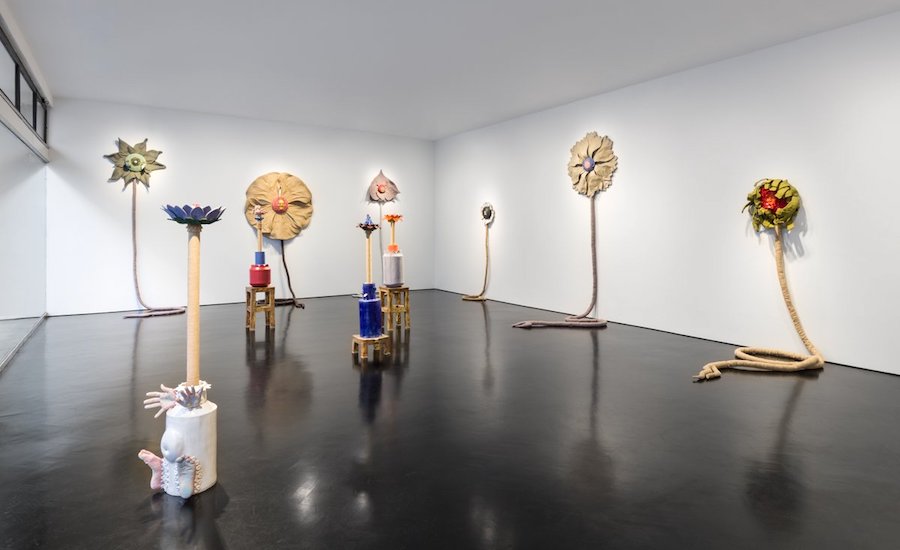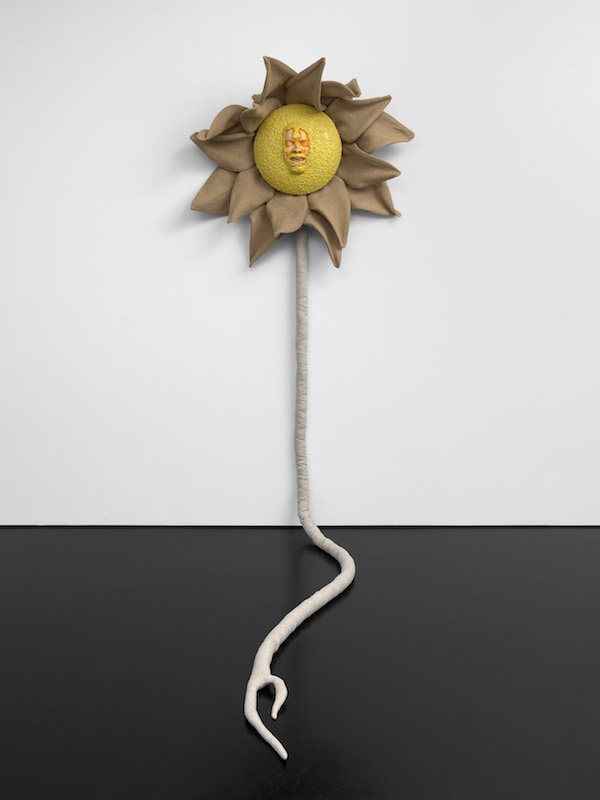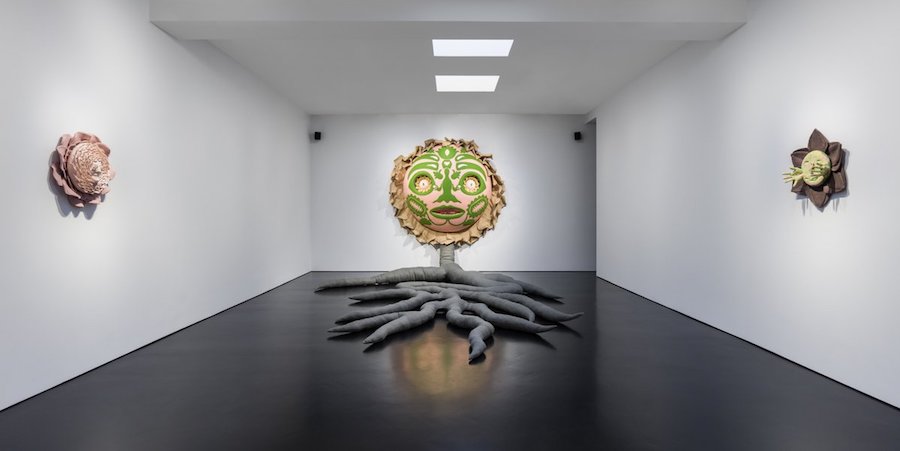Jonathan Baldock works across sculpture, installation and performance. He has a way with unexpected faces – as in his long-running series of ceramic masks – and it’s plants that take them on in his solo show ‘we are flowers of one garden’. The installation is humorous, theatrical and camp but also macabre, simultaneously considering change, ageing, grief and loss in the context of his personal history and the history of working-class culture.
What’s with the pinstripe coat?
I thought I’d fit in with the business style of Mayfair without going so far as wearing a suit…
We enter a garden of sorts?
Yes, the front space is set up like a garden, with vase pieces like figures, flowers like faces, hands like flowers…
What’s the show about?
My Mum and her garden. I was sitting in my Mum’s garden, and though I’ve always told people I don’t come from an artistic background, I suddenly thought, ‘I do!’ – seeing the garden as an outpouring of creativity. My Mum’s a really keen gardener, and that her outlet – there’s pride, yes, but also something deeply personal and spiritual about it. And I thought I wanted to make an exhibition about this. We moved house a lot, but every time Mum made the most of the garden. The garden she has now isn’t big – maybe 10m x 10m – but she really packs the plants in, so the borders have taken over the centre.

Is it a rather personal show?
It’s more personal than any show I’ve done, so I can’t separate myself from it in the way I usually can. My Mum is directly present – this is the first time I’ve cast a body other than my own. There is something about me moving away from the countryside to London, how I look to nature for comfort now. And flowers are a metaphor for life – they need nurturing and looking after – so the mirroring with the relationship of gardener to a parent seemed really beautiful. And the year making the show allowed me to spend time with my Mum. I hope I’m not candy-coating it, but it absolutely comes from a place of love – Mum’s my number one. And I hope that’s reflected in the work. Any relationship has its ups and downs, but I do think my Mum did her best for me and I adore her for that. And as you get older, you start seeing your parents in yourself.

Do the flowers represent you and your mother?
No, I look at them as their own beings, even though the Mother Flower is the only work which doesn’t have any casts from either my body or my mother. That represents the interconnectedness of nature. The roots are about connectedness and the mother tree philosophy. It’s about how we understand the natural world, how we used to think we were above it but now we realise we’re all just a part of it. ‘Mother Flower’ is covered with European folk emblems. There’s a Hungarian flower motif with a razor blade look. The nose is from Germany, the eyebrows are Polish, and the eyes are from a Dutch shape. I love folk motifs as they tell of people who worked closely with nature, and they probably go back further than we know, as history isn’t written by the poor. And they seem to have a common aesthetic, so they work well together.
Why do some flowers have roots and some not?
The sculptures have roots, though not all are displayed with them. Buy a flower and you get a root free! I wanted to vary it so that some have that rat’s tail look, but others are more floating and solar. I see the roots as mandrakes – as having a limb-like quality.
What materials have you used?
Everything you see is either from plants or else is clay – the earth they grow in. So you have hessian, linen, and felt. I also wanted some scent, so there are dried flowers in the mouths: rose, lavender, hibiscus, and chamomile. I’ve used applique – I love that because it’s an embroidery technique rooted in the history of working people as a way to put scraps of fabric together to make clothes and decorations. And the trace of the hand in the stitch is important to me, like handwriting or a trace of the body.

Some of the colours are more bodily than floral?
Totally. I wanted to present them as fleshy, and I’ve reversed the colours so that the petals are always drained of colour and the centre is bright.
What’s the soundtrack?
My mother’s family were hop pickers. That’s a way of life that doesn’t really exist anymore. And hops also have flowers. You can hear samples from my granddad – who worked in the hop fields – playing the accordion and my mother and I singing the Dolly Parton song ‘Wildflowers’, the lyrics of which provide the titles for all the works. Dolly is an artist I love, and apart from being a beautiful song about flowers, ‘Wildflowers’ is essentially a song about being free to be yourself. From a queer perspective, that was always going to resonate.
‘Just a wild mountain rose’ is cast from your mother’s face?
Yes. Casting faces relates to death masks – but this is about keeping her forever. It also makes her a little psychedelic, blissed out. And the use of linen adds a theatrical element, as in stage backdrops.
‘Wildflowers don’t care where they grow’, is you?
Me with chamomiles in my mouth.
Are the flowers particular species?
No, I looked at lots of flowers, but these are all imaginary hybrids of their features. Some have a folk motif; some are more real.

Installation view (back room): Courtesy of the artist and Stephen Friedman Gallery, London. Photo by Mark Blower.
They strike me as more active than most flowers in art?
Yes, I like the idea that the flowers are powerful beings in their own right. They could do something, could carry emotions, and are a little bit… scary! Perhaps they could eat you…
And extrovert – like you?
People think I’m a gregarious and outgoing extrovert, but that’s not really true; it’s performative. And that’s in the work – it’s like a mask – there’s performativity. I’m an introverted extrovert, constantly trying to communicate what it is to be human.
The works look as if they were fun to make?
Totally. A lot of this is channelling joy, and as a maker, I love making; that’s my favourite part of being an artist.
What did your mother make of the show?
I am very happy and relieved to report that she loved it!
Top Photo: Jonathan Baldock with ‘Mother Flower’ 2022, photo © Paul Carey-Kent Artlyst 2023
Jonathan Baldock’s ‘we are flowers of one garden’ runs at Stephen Friedman Gallery until 25 February 2023.

